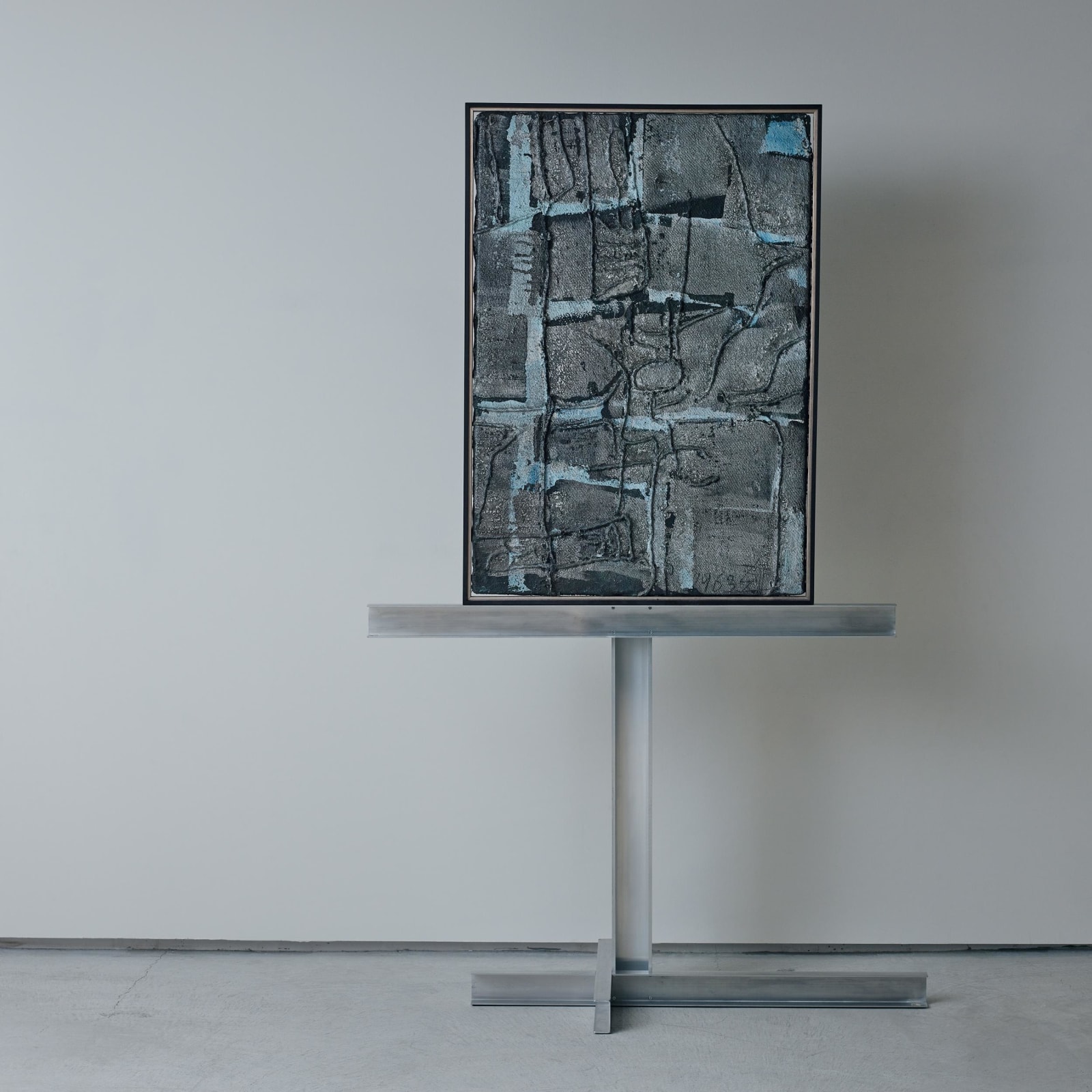Suda Kokuta (1906–1990)
Work
Oil and duralumin pigment on dungaree, framed
1963
Signed by the artist on the reverse
118 x 82 cm
122 x 86 cm (overall)
At a medium-to-large size of P50, Work is a striking example of Suda Kokuta’s attempt to break with the two-dimensional surface of painting. Seen from a distance, it may seem completely flat, but upon closer inspection one discovers that Work is intricately structured by a labyrinthian configuration of lines protruding from the painting’s surface. Just by themselves, these lines evoke an archaic quality: scribbles or bone incisions from prehistoric cultures may come to mind, perhaps children’s drawings. Suda uses a rough-woven dungaree fabric similar to jute bags as painting ground. He apparently kept the linear bulges in place by sewing the fabric together from the back, left and right of the desired line—a cumbersome process that stands in stark contrast with the more relaxed, spontaneous application of colors.
Work is dated 1963. It is similar to Suda’s Work 1953-O1, done a whole decade earlier and now in the collection of the Iida City Museum (Nagano Prefecture). Like the present painting, Work 1953-O1 is made using dungaree and oil colors, and its most distinct feature is its mesh of linear protrusions that appear like seams and line drawing at the same time, and greatly resemble Work in their arcane quality. This suggests that Suda experimented with the approach earlier, and might have reactivated the previously tried technique in a more elaborate manner about a decade later. Much of the haptic quality of Work 1953-O1 is due to the raw, almost unaltered dungaree fabric (only some areas in the upper part and near the center are painted), but the present Work is covered allover with roughly rectangular patches of a silver-metallic color, interspersed with areas of black and an almost white blue. The metallic appearance likely results from the use of duralumin pigment; this layer of paint was applied last.
Another parallel that is readily apparent are the works of Gutai member Maekawa Tsuyoshi. Like Suda in this work, Maekawa is known for using rough fabric (burlap) as painting ground; moreover, his signature technique of creating dense patterns of “lines” formed over or from the burlap material is reminiscent of Suda’s approach here. In that sense, Work shares aesthetic and conceptual concerns that were characteristic for the postwar generation of artists not only in Japan but also in the Western sphere, including the blurring of the distinction between painting and object—Suda would often emboss his works, use thick impasto paint, or incorporate “non-artistic” objects like pebbles and stones to create three-dimensional surfaces—, and a predilection for raw, unrefined materials that initially was often a consequence of material scarcity, but quickly came to be employed as a strategy to challenge academism and draw attention to the physicality of the artwork.
Suda Kokuta (painter; 1906–1990)
Painter from Saitama Prefecture near Tokyo. Suda exhibited at Bunten, Nitten and other major competitive exhibitions including the Japan Contemporary Art Exhibition as well as abroad. Displaying uninhibited and vigorous brushwork, he stood out for his energetic style. He also ventured into calligraphy and ceramics. In 1983, Suda received the 14th Kodansha Culture Award for his illustrations to Shiba Ryotaro’s series of travel essays, On the Highways (Kaido wo yuku). Member of the Kokuga (“national painting”) art association.
Work is dated 1963. It is similar to Suda’s Work 1953-O1, done a whole decade earlier and now in the collection of the Iida City Museum (Nagano Prefecture). Like the present painting, Work 1953-O1 is made using dungaree and oil colors, and its most distinct feature is its mesh of linear protrusions that appear like seams and line drawing at the same time, and greatly resemble Work in their arcane quality. This suggests that Suda experimented with the approach earlier, and might have reactivated the previously tried technique in a more elaborate manner about a decade later. Much of the haptic quality of Work 1953-O1 is due to the raw, almost unaltered dungaree fabric (only some areas in the upper part and near the center are painted), but the present Work is covered allover with roughly rectangular patches of a silver-metallic color, interspersed with areas of black and an almost white blue. The metallic appearance likely results from the use of duralumin pigment; this layer of paint was applied last.
Another parallel that is readily apparent are the works of Gutai member Maekawa Tsuyoshi. Like Suda in this work, Maekawa is known for using rough fabric (burlap) as painting ground; moreover, his signature technique of creating dense patterns of “lines” formed over or from the burlap material is reminiscent of Suda’s approach here. In that sense, Work shares aesthetic and conceptual concerns that were characteristic for the postwar generation of artists not only in Japan but also in the Western sphere, including the blurring of the distinction between painting and object—Suda would often emboss his works, use thick impasto paint, or incorporate “non-artistic” objects like pebbles and stones to create three-dimensional surfaces—, and a predilection for raw, unrefined materials that initially was often a consequence of material scarcity, but quickly came to be employed as a strategy to challenge academism and draw attention to the physicality of the artwork.
Suda Kokuta (painter; 1906–1990)
Painter from Saitama Prefecture near Tokyo. Suda exhibited at Bunten, Nitten and other major competitive exhibitions including the Japan Contemporary Art Exhibition as well as abroad. Displaying uninhibited and vigorous brushwork, he stood out for his energetic style. He also ventured into calligraphy and ceramics. In 1983, Suda received the 14th Kodansha Culture Award for his illustrations to Shiba Ryotaro’s series of travel essays, On the Highways (Kaido wo yuku). Member of the Kokuga (“national painting”) art association.
